

 |
Search the Site with

|
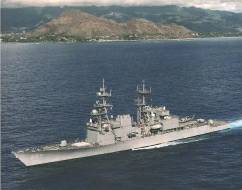 | 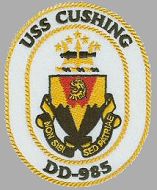 | 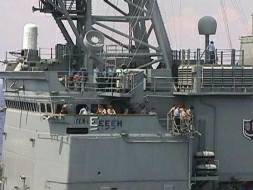 |
USS CUSHING was the 23rd SPRUANCE - class destroyer and the last ship in her class to be decommissioned. The CUSHING was last homeported in Yokosuka, Japan., and after decommissioning she was laid-up at the Naval Inactive Ships Maintenance Facility in Pearl Harbor, HI., awaiting transfer to the Turkish Navy. However, those plans were canceled and the CUSHING was sunk as a target during RIMPAC 2008. The destroyer was sunk in July 2008 north off Kauai, Hawaii.
| General Characteristics: | Awarded: January 15, 1974 |
| Keel laid: December 27, 1976 | |
| Launched: June 17, 1978 | |
| Commissioned: September 21, 1979 | |
| Decommissioned: September 22, 2005 | |
| Builder: Ingalls Shipbuilding, West Bank, Pascagoula, Miss. | |
| Propulsion system: four General Electric LM 2500 gas turbine engines | |
| Propellers: two | |
| Blades on each Propeller: five | |
| Length: 564,3 feet (172 meters) | |
| Beam: 55,1 feet (16.8 meters) | |
| Draft: 28,9 feet (8.8 meters) | |
| Displacement: approx. 9,200 tons full load | |
| Speed: 30+ knots | |
| Aircraft: two | |
| Armament: two | |
| Crew: approx. 340 |
Crew List:
This section contains the names of sailors who served aboard USS CUSHING. It is no official listing but contains the names of sailors who submitted their information.
USS CUSHING Cruise Books:
About the Ship's Coat of Arms:
 USS CUSHING's coat of arms symbolizes the spirit and endeavors of William Barker Cushing, as well as the tradition of destroyers named in honor of this brave naval officer. The predominant colors of dark blue and gold are traditionally associated with the Navy and symbolize the sea and excellence. The indented division of the shield represents a log boom and pile and is suggestive of the manner in which Commander Cushing accomplished the sinking of the Albemarle. The upper area of the pile is red, alluding to the danger of this famous action and that Commander Cushing was under enemy fire more than any other Union Navy officer. The lion's head is a symbol of courage and strength and signifies the character of Commander Cushing. His spirit is also reflected in the ship's motto, "NON SIBI SED PATRIAE", a statement attributed to the ancient Roman Cicero that translates to "Not for Self but for Country".
USS CUSHING's coat of arms symbolizes the spirit and endeavors of William Barker Cushing, as well as the tradition of destroyers named in honor of this brave naval officer. The predominant colors of dark blue and gold are traditionally associated with the Navy and symbolize the sea and excellence. The indented division of the shield represents a log boom and pile and is suggestive of the manner in which Commander Cushing accomplished the sinking of the Albemarle. The upper area of the pile is red, alluding to the danger of this famous action and that Commander Cushing was under enemy fire more than any other Union Navy officer. The lion's head is a symbol of courage and strength and signifies the character of Commander Cushing. His spirit is also reflected in the ship's motto, "NON SIBI SED PATRIAE", a statement attributed to the ancient Roman Cicero that translates to "Not for Self but for Country".
The trident is a traditional maritime symbol and its sharp points suggest offensive action. The spar torpedo is dark blue alluding to the dark night and the covert nature of the sinking of the Albemarle. The dark blue also recalls the fact that Commander Cushing took the torpedo, at that time a Confederate weapon, and successfully used it to sink an enemy vessel. The five stars refer to the fact that today's USS CUSHING is the fifth ship in the U. S. Navy with this name.
Accidents aboard USS CUSHING:
| Date | Where | Events |
|---|---|---|
| August 12, 1998 | Okinawa | Petty Officer 3rd class Christopher Eric Wise was killed by the rupture of a steam pipe in a bathroom aboard the USS CUSHING, which was at port in Okinawa at the time. He was pronounced dead at the Navy Hospital in Okinawa, where he was taken after the accident. Another injured sailor, whose name was not released, was also taken to same hospital for treatment for first- and second-degree burns, the Navy said. The sailor was in stable condition. |
| July 5, 2002 | Persian Gulf | While attempting to land aboard the USS CUSHING, a SH-3 Sea King helicopter experiences tail rotor problems causing the helicopter to rotate out of control. The helicopter subsequently crashes on CUSHING's flight deck before going over the side. All seven crew onboard the SH-3 are recovered safely. Click here to view a clip of the accident. (.wmv file, 715 KB) |
History of USS CUSHING:
USS CUSHING is the twenty-third SPRUANCE-class Destroyer to be designed and built by Ingalls Shipbuilding Division of Litton Industries in Pascagoula, Mississippi. Homeported in Yokosuka Japan, CUSHING is assigned to Commander, Destroyer Squadron Fifteen.
As part of a 1995 reorganization of the Pacific Fleet's surface ships into six core battle groups and eight destroyer squadrons, with the reorganization scheduled to be completed by October 1, and homeport changes to be completed within the following year, USS CUSHING was reassigned to Destroyer Squadron 5.
A prototype Remote Minehunting System (RMS) was installed onboard USS CUSHING in time for the fall 1996 USS KITTY HAWK deployment to provide the Battle Group with a mine reconnaissance capability. This was an upgrade of the system successfully used in 1995 with the additional capability for shipboard launch and recovery and direct interface to the shipboard system. In FY 1997, the RMS concept was successfully demonstrated by employment of a prototype system from USS CUSHING during an Arabian Gulf exercise.
In early 1997, USS CUSHING was conducting Maritime Interception Operations in the Arabian Gulf.
USS CUSHING departed Pearl Harbor, HI, on March 16, 1998, for its new home port of Yokosuka, Japan. USS CUSHING had been homeported in Pearl Harbor since 1991 and was set to replace the USS FIFE (DD 991) which was changing homeports to Everett, WA. During its time in Pearl Harbor, USS CUSHING made four western Pacific deployments and one to the South Atlantic. Upon arrival in Japan, USS CUSHING was assigned to Commander, Destroyer Squadron 15, and deployed in May to participate in CARAT '98, a multi-national exercise with navies of Southeast Asian nations. CARAT '98 was the fourth annual Cooperation Afloat Readiness and Training (CARAT) exercise held between the United States and six Southeast Asia countries from May 12 to August 5, 1998. As part of a series of bilateral training exercises, CARAT 98 had U.S. forces training with military forces of Brunei, Indonesia, Malaysia, Thailand, Singapore and the Philippines. CARAT 98 demonstrated U.S. commitment to security and stability in Southeast Asia while increasing the operational readiness and capabilities of U.S. forces. The exercise also promoted interoperability and cooperation with U.S. regional friends and allies by offering a broad spectrum of mutually beneficial training opportunities.
USS CUSHING, from March 22 to March 25, 1999, along with Battle Force 7th Fleet took part in a multi-national live-fire missile exercise (MTX 99) in waters near the Marianas Islands. Also involved in the MTX 99 were naval units from Australia, Canada, Singapore and the Republic of Korea. Fired during MTX 99 were live weapons which included Harpoon, Penguin and Maverick missiles, torpedoes and various shipboard weapons systems. The former USS OKLAHOMA CITY was used as the target vessel. OKLAHOMA CITY had been commissioned as a light cruiser (CL 91) in 1944. She had participated in the Battle of Okinawa prior to being decommissioned in 1947, before being recommisioned in 1960 as a guided missile light cruiser (CLG 5), serving in the Vietnam War and making several deployments to WESTPAC to serve as the 7th Fleet flagship prior to finally being decommissioned and stricken from the naval register in 1979.
USS CUSHING took part in the 38th Foal Eagle exercise held in the fall of 1999. A regularly scheduled exercise, Foal Eagle combined forces from the Republic of Korea (ROK) with US ones. In August 2000, USS CUSHING took part in SHAREM 138. USS CUSHING and various units in the Foward Deployed Naval Force (FDNF), participated in SHAREM (Ship ASW Readiness Effectiveness Measuring) 138 along with units from the host, Japan Maritime Self Defense Force near Okinawa, Japan. Although weather conditions curtailed SHAREM events, valuable training was accomplished in the Art of Undersea Warfare(USW).
USS CUSHING took part in Missile exercise (MISSILEX) 01-1 which was held November 17-18, 2000 as part of a coordinated task group operation.
During a Naval Surface Fire Support exercise held near Guam on December 4-5, 2000, USS CUSHING posted a better-than-perfect score during a gun shoot. The exercise was designed to test the accuracy and effectiveness of CUSHING’s guns and the proficiency of its watch teams. When the dust settled and the grade sheets were tallied, with bonus points for superior communications performance, CUSHING was awarded 101.5 points out of 100.
USS CUSHING was honored by Commander, Destroyer Squadron 15, when it received the Silver Enlisted Surface Warfare Excellence Pennant on January 25, 2001. As a result, CUSHING was now authorized to fly the pennant as all enlisted personnel E5 and senior have qualified as enlisted surface warfare specialists within the required time standard set forth by the Chief of Naval Operations. CUSHING was the first ship of Destroyer Squadron 15 to qualify for this prestigious award.
CUSHING's aggressive enlisted surface warfare program entails daily training, both underway and inport. The lecture series involved builds a foundation for the crew to obtain a knowledge of the fundamentals of surface warfare. Then personnel have to go through every part of the ship and obtain signatures on individual combat systems, engineering, deck and damage control items, among others and show that they understand how the ship works. After completing all the knowledge requirements listed in their qualification books, candidates then must pass a rigorous written examination and an oral qualification board. The pennant embodies the warrior spirit of the crew's enlisted surface warfare specialists. For individual Sailors, earning the pin requires extensive research, observation, study and knowledge of all surface warfare mission areas: combat systems, operations, navigation, engineering and supply.
From January to March 2001, USS CUSHING underwent a series of upgrades to its weapons and engineering systems.
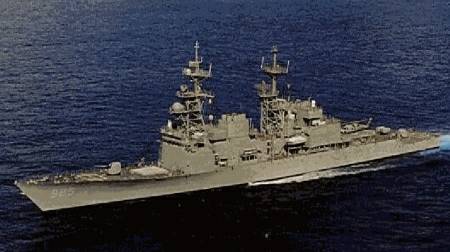
About the Destroyer’s Name, about Commander William Barker Cushing:
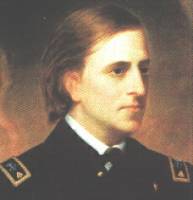 USS CUSHING is named after Commander William Barker Cushing, a Naval hero of the American Civil War. Born in Delafield, Wisconsin, November 4, 1842, he entered the Naval Academy in 1857. He earned the rank of Lieutenant on July 16, 1862, and subsequently attained the rank of Commander on January 31, 1872.
USS CUSHING is named after Commander William Barker Cushing, a Naval hero of the American Civil War. Born in Delafield, Wisconsin, November 4, 1842, he entered the Naval Academy in 1857. He earned the rank of Lieutenant on July 16, 1862, and subsequently attained the rank of Commander on January 31, 1872.
After a brilliant service in the blockading fleet off the North Carolina coast, his plans were to outfit the torpedo boats with a spar torpedo and destroy the formidable and dangerous Confederate ram ALBERMARLE. The ALBEMARLE had sunk or damaged several Union warships during the Spring and Summer of 1864 and was causing considerable apprehension in Washington D.C. because no Union ironclad could navigate the shoals off the North Carolina coast. This allowed the ports in the area to remain open to blockade runners as ALBEMARLE could destroy the wooden inshore blockading squadron. LT Cushing proposed a small boat attack on the ironclad using boats of his own design. The Navy Department agreed and sent the twenty-one year old officer to New York to have the boats built.
On the night of October 27, Cushing led seven volunteers in one of his small steam driven boats up the Roanoke River into North Carolina. His only weapon was a "torpedo" suspended forward of his craft by a twenty foot boom or spar. The torpedoes of that time were similar to what are now called mines in that they were not self-propelled. As Cushing approached ALBEMARLE, his boat was detected and was fired upon from the shore. By the light of a Confederate bonfire on the near bank, Cushing observed ALBEMARLE was protected by a semi-circle of floating logs. Pressing the attack, Cushing rammed the barrier at full speed causing his boat to stick fast less than ten yards from the mighty ironclad. From this position, by the use of lines he controlled while standing in the bow, Cushing lowered the torpedo into the water, released it, waited for the torpedo to settle under the ironclad, then detonated it. At the instant the torpedo, exploded the fatally crippled ALBEMARLE fired one of its eight inch guns at Cushing's craft. Fortunately, the gun could not be depressed enough to hit the boat, but the concussion swamped it. Cushing and a few others dove into the river attempting to escape. Although everyone else in his crew was either killed or captured, Cushing himself eluded his pursuers and managed to work his way through enemy territory to the coast where he was picked up by the blockading Union forces. For this action Cushing was promoted meritoriously to lieutenant commander and received the official thanks of Congress, the only non-flag officer of the Civil War to be so honored. Four years after graduating from the Naval Academy, William Barker Cushing was promoted to the rank of Commander.
After the Civil War, he served in both the Pacific and Asiatic squadrons; commanded LANCASTER, and MAUMEE; served as ordnance officer, Boston Navy Yard; and from July 11, 1873 commanded USS WYOMING until relieved of active duty because of illness.
The boldness he displayed during the war was readily apparent in his later career, as exemplified by an incident that occurred while he was commanding USS WYOMING in the Caribbean. Cushing helped to free the passengers of a ship being detained by the Spanish government in Cuba by threatening to shell the city of Havana if the passengers were not released.
Commander Cushing died on 17 December 1874 of a painful back ailment, probably caused by the physical abuse his body had taken during his life. He was survived by his mother, his wife, two daughters, and one of his brothers. He had two other brothers; one died during the Battle of Gettysburg, and the other died fighting the Apache in 1871.
USS CUSHING Patch Gallery:
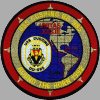 |  |  |
USS CUSHING SinkEx:
The video below shows the CUSHING being sunk as a target during exercise RIMPAC 2008 off the Hawaiian Islands on July 14, 2008.
USS CUSHING Image Gallery:
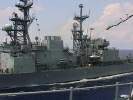 | 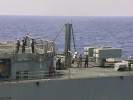 | 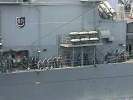 | 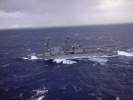 | 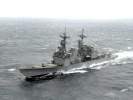 |
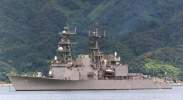 | 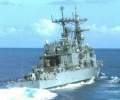 | 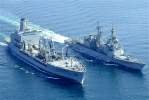 | 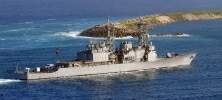 | |
 | 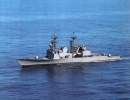 | 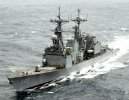 | 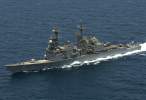 | 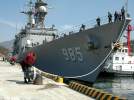 |
The photo below was taken by me on July 29, 2006, and shows the CUSHING [front] berthed at the Naval Inactive Ships Maintenance Facility in Pearl Harbor, HI. The ship in the middle is the FLETCHER (DD 992) and the ship in the background is the VALLEY FORGE (CG 50).
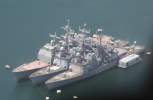 |
 Back to Destroyers list.
Back to Destroyers list.  Back to ships list.
Back to ships list.  Back to selection page.
Back to selection page.  Back to 1st page.
Back to 1st page.